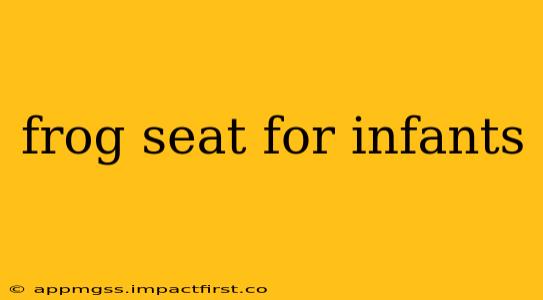Choosing the right seating solution for your little one can feel overwhelming. With so many options on the market, it's essential to understand what features make a frog seat suitable (or not) for infants. This comprehensive guide will delve into the world of infant frog seats, addressing common questions and helping you make an informed decision.
What is a Frog Seat for Infants?
A frog seat, also sometimes called a baby frog seat or infant froggy seat, isn't a standardized product like a car seat or high chair. The term generally refers to a supportive seat designed to mimic a frog's posture, with legs spread apart. These seats often feature a wide, upright base and curved leg supports intended to promote good posture and hip development. It's crucial to note that these are NOT designed to replace safe, regulated infant seating solutions like car seats, bouncers, or baby carriers. They are supplementary items, often used for short periods for activities like feeding, playing, or tummy time.
Are Frog Seats Safe for Infants?
The safety of a frog seat depends entirely on its design and the way it's used. Many so-called "frog seats" sold online lack proper safety certifications and are not designed to support an infant's delicate spine and hips. The key is to look for features like:
- Proper Support: The seat should provide adequate support for the baby's head, neck, and back. It shouldn't allow the baby to slump or lean too far forward or backward.
- Stable Base: A wide, sturdy base is vital to prevent tipping.
- Secure Straps or Restraints: While not always present, secure straps or restraints are a huge plus for safety.
- Age and Weight Appropriateness: Always check the manufacturer's recommendations for age and weight limits.
Never leave your baby unattended in a frog seat. Always supervise them closely. If you have any doubts about the safety of a particular seat, it's best to err on the side of caution and choose a different option.
What are the Benefits of a Frog Seat?
While not scientifically proven benefits, some parents believe that frog seats offer certain advantages:
- Posture Support (with proper design): Some believe the frog-like position can encourage good posture development, though this needs more research. However, it is not a replacement for proper developmental guidance from a pediatrician.
- Improved Tummy Time: The position can make tummy time slightly more comfortable for some infants, which is crucial for muscle development.
- Engagement: The upright position can allow infants to interact more easily with their surroundings.
What are the Drawbacks of a Frog Seats?
The potential drawbacks of frog seats often outweigh the perceived benefits, particularly those lacking proper safety certifications:
- Risk of Injury: Poorly designed seats can cause spinal problems or hip dysplasia.
- Lack of Safety Regulations: Unlike car seats or high chairs, many frog seats are not subject to rigorous safety testing.
- Limited Functionality: They aren't suitable for prolonged use and can't replace safe infant seating solutions.
- Potential for Falls: An unstable seat increases the risk of falls and injuries.
How Long Can Babies Sit in a Frog Seat?
Babies should only be placed in a frog seat for very short periods and always under close adult supervision. It’s not suitable for sleeping or extended periods of sitting. The maximum time should be determined based on the baby's comfort level and the design of the seat. If the baby shows signs of discomfort, remove them from the seat immediately.
Are Frog Seats Appropriate for All Infants?
No, frog seats are not appropriate for all infants. Premature babies or those with developmental delays should absolutely not be placed in a frog seat without the explicit approval of a pediatrician or physical therapist. Babies with weak neck muscles or other medical conditions may also be unsuitable candidates.
What are the Alternatives to Frog Seats?
Safe and effective alternatives for infants include:
- Infant Car Seats: Essential for transportation and offering excellent safety features.
- Bouncers: Provide comfortable support for playtime and naps.
- Baby Carriers: Offer hands-free carrying and bonding opportunities.
- High Chairs (age-appropriate): Support safe and comfortable feeding.
This guide aims to inform parents about infant frog seats. Always prioritize your baby's safety and consult your pediatrician if you have any concerns about the appropriateness of any seating product. Remember, safe and regulated products are essential for your little one's well-being.
